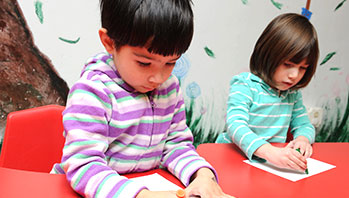- chart paper (titled “What’s Underground?”)
- crayons
- markers
- squares of paper
- tape
- dirt
- leaves
- stretch
- squeeze
- worm
MA Standards:
English Language Arts/Foundational Skills/RF.PK.MA.1: With guidance and support, demonstrate understanding of the organization and basic features of printed and written text: books, words, letters, and the alphabet.
English Language Arts/Writing/W.PK.MA.1: Dictate words to express a preference or opinion about a topic (e.g., “ I would like to go to the fire station to see the truck and meet the firemen.”)
Head Start Outcomes:
Language Development/Expressive Language: Uses language to express ideas and needs.
Literacy Knowledge/Print Concepts and Conventions: Understands conventions, such as print moves from left to right and top to bottom of a page.
Literacy Knowledge/Early Writing: Recognizes that writing is a way of communicating for a variety of purposes, such as giving information, sharing stories, or giving an opinion.
Literacy Knowledge/Early Writing: Uses scribbles, shapes, pictures, and letters to represent objects, stories, experiences, or ideas.
PreK Learning Guidelines:
English Language Arts/Composition 16: Use their own words or illustrations to describe their experiences, tell imaginative stories, or communicate information about a topic of interest.
Draw and Write Together: What We Learned About Worms

© Commonwealth of Massachusetts, Department of Early Education and Care (Jennifer Waddell photographer). All rights reserved.
STEM Key Concepts: Earthworms are animals that live in the soil, underground
ELA Focus Skills: Concepts of Print (Directionality, Print Conveys Meaning)
Have children revisit the worm habitat and observe any changes. Give children drawing materials and have them draw a picture of something they learned about worms. Then have children dictate or write captions to add to their drawing, such as,
- Worms live in the dirt.
- Worms stretch out and then squeeze up their bodies to move.
- Worms eat dirt and rotting leaves.
As you write, talk about where on the page you begin to write, the letters in the words you are writing, and the spaces you leave between words. Read the entries back to children and encourage them to read as many words as possible along with you.
Have children tape their illustrations to the chart. You may want to place the chart in the area where the worms are so children can revisit and add to it when they observe the worms.
Social Emotional Tip: Offering opportunities for them to write as a group can help children develop an understanding of group dynamics and expectations and how one’s actions and thoughts can affect others.
